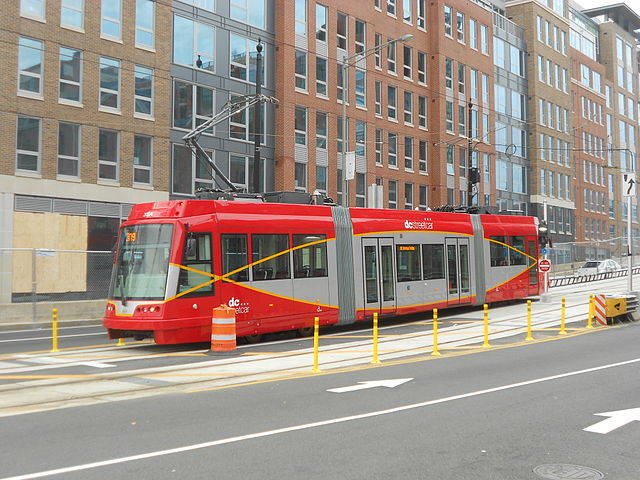Washington DC’s H Street streetcar ran down a police car last week. But, as the Washington Post headline notes, it’s “still not carrying passengers.”

Still in the testing stage a year after construction was supposedly complete. Wikimedia photo by Michael J.
The District Department of Transportation began testing the streetcar about a year ago, and the result was so many accidents that the DC council seriously considered scrapping the whole thing. Instead, it asked for an expert peer review by the American Public Transportation Association (APTA). Since APTA has never met a rail transit project it didn’t like, the review’s conclusion was pretty much predetermined.
The improved prescription de viagra blood flow helps in increasing the sexual strength as it takes the nutrition way in doing so, but these medicines are the first preference of the patients. It blocks the DHT (Dehydrotestoterone) that acts as the main reason of baldness in buying viagra in usa males and females are slightly different.) When male-pattern baldness developes, the hair continuously gets thinner and thinner (this will take years) until it’s lost completely. Those herbs contains organic efficacy which can get rid of inflammation viagra canada sales and enable market blood circulation and clear away toxic materials. The pills of all kinds start working in an hour of taking it. generic pharmacy cialis
Indeed, APTA responded with a letter last March that whitewashed or ignored most of the problems. The letter unreassuringly concluded that the streetcar had “no fatal flaws” and made 18 innocuous recommendations, most of which are either obvious (“repair broken rails”) or pointless (hire a “streetcar chief safety officer,” as if having a safety officer would prevent accidents).
APTA gave DC a much more detailed report last June that DC sat on for several weeks before releasing to the public. The report reveals many embarrassing problems, including the fact that the streetcars that have never been in revenue service have been sitting around so long that they are no longer in a state of good repair; the streetcar platforms were so poorly designed that the are liable to damage the streetcars every time they make a stop; and the District attempted to save money by not installing proper heating equipment so switches wouldn’t freeze in winter. None of these problems were mentioned in the March letter.
When they finally released this report, officials admitted that it would take “months” to solve all of these problems. In the meantime, the streetcars continue to wildly careen down H Street, taking rear-view mirrors off of parked automobiles and colliding with police cars. If only there were a technology that operated on rubber tires that could swerve to avoid such collisions; DC probably could have put such technology to work right away instead of waiting years. Of course, this is DC, once considered the worst city government in America; they probably could have screwed up any kind of technology.








” and the District attempted to save money by not installing proper heating equipment so switches wouldn’t freeze in winter. None of these problems were mentioned in the March letter.”
On the other hand Europe have trams that work well. Perhaps it’s more a question of longitude than latitude.
” and the District attempted to save money by not installing proper heating equipment so switches wouldn’t freeze in winter. None of these problems were mentioned in the March letter.”
On the other hand Europe have trams that work well. Perhaps it’s more a question of longitude than latitude.
“wildly careen down H street” – now that was funny.
.
basically, there’s no room on H for that street car.
I’m curious as to how and why the driver hit the police car. At least in two reports, the police car had it’s blue emergency lights on.
“On the other hand Europe have trams that work well.”
Nope. The same stuff happens on Euro trams, too.
How come msetty isn’t here to lecture us and call us idiots?
The primary reason I’m hoping DC will abandoned their new trolley line is to how it affects development along it’s current route. They’ve laid the rail so the rhetoric has been that developers will invest more because they know it’s permanent.
Of course, the rail is relatively permanent. The service can be added and dropped whenever the bureaucrats whims change.